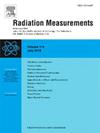Copper-based halide Cs3Cu2I5: (X) bulk single crystals: Growth and applications
IF 2.2
3区 物理与天体物理
Q2 NUCLEAR SCIENCE & TECHNOLOGY
引用次数: 0
Abstract
Low-dimensional copper-based halides have garnered wide attention due to their strong self-trapped exciton (STE) emission, among which, Cs3Cu2I5 (CCI), characterized by a zero-dimensional electronic structure, exhibits promising application potential across multiple fields owing to its non-toxicity and excellent environmental stability. Notably, its exceptional radioluminescence properties make it an outstanding scintillator material for high-energy radiation detection. In recent years, although reports on diverse CCI material morphologies abound, bulk single crystals have become the primary focus because of their superior light output and low defect density. In this review, we systematically summarize and discuss the growth methodologies and applications of CCI bulk single crystals, which encompasses both melt and solution growth techniques, as well as currently developed and potentially superior application scenarios. Furthermore, we dedicate a section to discuss doping engineering strategies applied to CCI materials and the resultant property enhancements. Finally, the key challenges and future research directions for CCI bulk single crystals are outlined.
铜基卤化物Cs3Cu2I5: (X)块状单晶:生长与应用
低维铜基卤化物因其强烈的自俘获激子(STE)发射而受到广泛关注,其中,Cs3Cu2I5 (CCI)具有零维电子结构,具有无毒性和优异的环境稳定性,在多个领域具有广阔的应用前景。值得注意的是,其特殊的辐射发光特性使其成为高能辐射探测的杰出闪烁体材料。近年来,尽管各种CCI材料形态的报道很多,但大块单晶由于其优越的光输出和低缺陷密度而成为主要焦点。在本文中,我们系统地总结和讨论了CCI块体单晶的生长方法和应用,包括熔体和溶液生长技术,以及目前发展和潜在的应用场景。此外,我们还专门讨论了应用于CCI材料的掺杂工程策略以及由此产生的性能增强。最后,对CCI本体单晶的关键挑战和未来的研究方向进行了概述。
本文章由计算机程序翻译,如有差异,请以英文原文为准。
求助全文
约1分钟内获得全文
求助全文
来源期刊

Radiation Measurements
工程技术-核科学技术
CiteScore
4.10
自引率
20.00%
发文量
116
审稿时长
48 days
期刊介绍:
The journal seeks to publish papers that present advances in the following areas: spontaneous and stimulated luminescence (including scintillating materials, thermoluminescence, and optically stimulated luminescence); electron spin resonance of natural and synthetic materials; the physics, design and performance of radiation measurements (including computational modelling such as electronic transport simulations); the novel basic aspects of radiation measurement in medical physics. Studies of energy-transfer phenomena, track physics and microdosimetry are also of interest to the journal.
Applications relevant to the journal, particularly where they present novel detection techniques, novel analytical approaches or novel materials, include: personal dosimetry (including dosimetric quantities, active/electronic and passive monitoring techniques for photon, neutron and charged-particle exposures); environmental dosimetry (including methodological advances and predictive models related to radon, but generally excluding local survey results of radon where the main aim is to establish the radiation risk to populations); cosmic and high-energy radiation measurements (including dosimetry, space radiation effects, and single event upsets); dosimetry-based archaeological and Quaternary dating; dosimetry-based approaches to thermochronometry; accident and retrospective dosimetry (including activation detectors), and dosimetry and measurements related to medical applications.
 求助内容:
求助内容: 应助结果提醒方式:
应助结果提醒方式:


